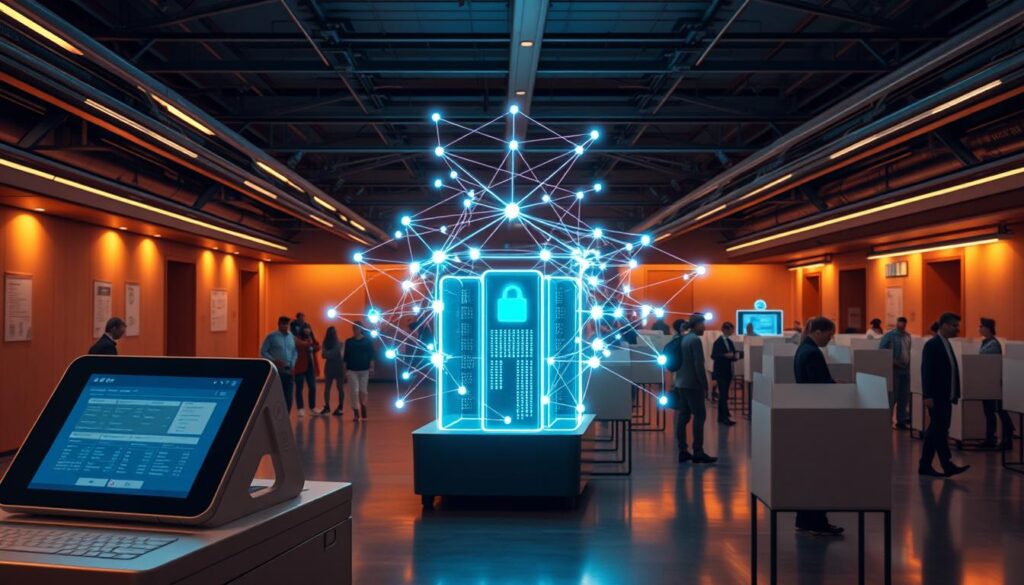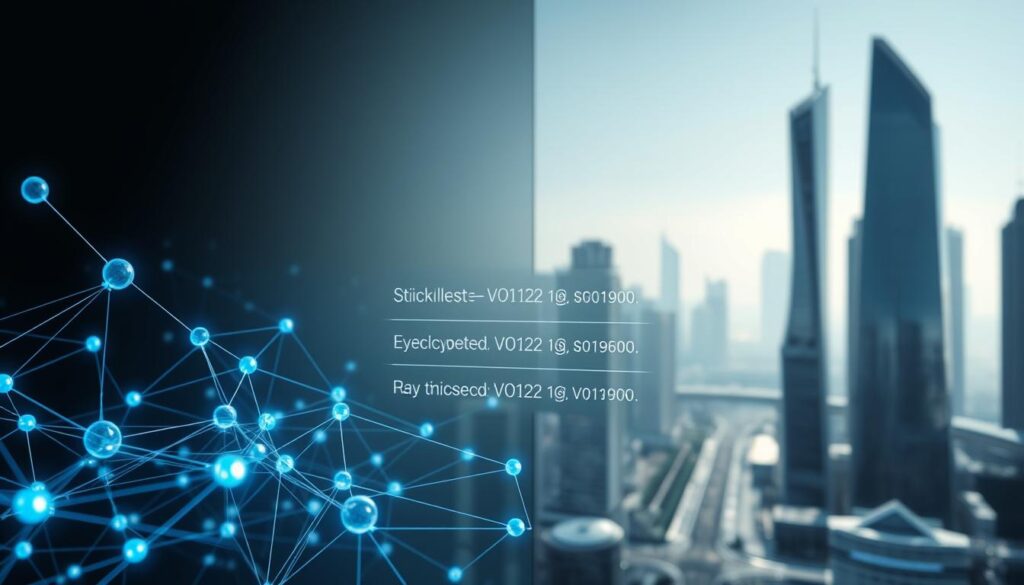Now Reading: Blockchain Governance Decentralized Voting System Explained
- 01
Blockchain Governance Decentralized Voting System Explained
Blockchain Governance Decentralized Voting System Explained

This article explores a new way to handle elections. It combines modern technology with the basic need for fair and secure voting. The goal is to create a process that everyone can trust.
Traditional methods face many problems. Security issues and a lack of clear records can cause doubt. This new approach aims to solve these fundamental challenges.
The technology behind this idea creates a permanent, unchangeable record. Every single vote is logged securely. This ensures the integrity of the entire election process.
We will look at the promising advantages and the important security points to consider. Understanding both sides is crucial for officials and voters alike.
By the end of this guide, you will know how this digital voting method works. You will see its potential to modernize how we conduct democratic events.
Key Takeaways
- This approach addresses key weaknesses in traditional and electronic voting methods.
- The core technology creates a transparent and verifiable record of every vote.
- Election integrity and accessibility for voters are primary goals.
- Both significant benefits and critical security considerations exist.
- The content provides a balanced view for evaluating this modern solution.
- Recent global events have increased interest in remote and digital voting alternatives.
Understanding Blockchain governance decentralized voting system
A fundamental shift from centralized control characterizes this new approach to casting and counting ballots. It merges democratic principles with a distributed digital ledger. The goal is an election framework where power is spread across a network.
This technology operates on a simple but powerful idea. Instead of one central database, the data exists on many computers at once. Each cast ballot becomes a permanent entry, verified by the network.
This structure offers a significant advantage in resilience. If one computer fails or is attacked, the others preserve the complete record. The integrity of the entire process remains secure.
Voters get a unique transaction ID as proof their choice was logged. They can later check this ID to confirm their participation. This provides transparency while keeping their actual vote secret.
The underlying blockchain process uses consensus to validate each action. This ensures only legitimate, authenticated inputs are counted. It creates a system of distributed trust, replacing blind faith in a single authority.
The Evolution of Voting Systems and the Need for Innovation
From ancient paper ballots to modern electronic machines, voting technologies have evolved to address changing needs and challenges. Each new method attempted to improve accuracy and efficiency in the electoral process.
| Voting Method | Era | Key Advantages | Major Limitations |
|---|---|---|---|
| Paper Ballots | Traditional | Physical audit trail, simple to understand | Manual counting, long queues, storage issues |
| Mechanical Machines | Early 20th Century | Faster than manual counting | Mechanical failures, no paper record |
| Electronic Systems | Modern Era | Quick results, accessibility features | Software vulnerabilities, technical glitches |
| Optical Scan | Contemporary | Combines digital speed with paper backup | Still requires physical presence, scanning errors |
Current electoral systems face significant challenges. Security breaches and accessibility barriers affect many voters. The paperwork-intensive nature also creates environmental concerns.
Long lines during elections demonstrate the time-consuming nature of traditional methods. Differently-abled voters often struggle to reach polling locations. These limitations highlight the urgent need for innovation.
Modern technology offers pathways to address these historical challenges. The goal is to create voting systems that balance accessibility with security. Society needs solutions that function during emergencies while maintaining election integrity.
How Blockchain Technology Enhances Voting Security
Election integrity receives a significant boost from distributed ledger technology’s inherent safeguards. This approach creates a protective framework that addresses common vulnerabilities in digital elections.
The core strength lies in permanent record-keeping. Once ballot information enters the digital ledger, it becomes unchangeable. This immutability prevents tampering with historical data.
| Security Feature | Traditional Systems | Blockchain Approach |
|---|---|---|
| Data Modification | Update/delete operations possible | Only addition allowed |
| Attack Resistance | Single point of failure | Distributed network protection |
| Verification Process | Centralized authority | Multiple node consensus |
| Audit Trail | Limited transparency | Complete transaction history |
Cryptographic techniques provide additional protection. Each ballot connects mathematically to previous entries. Any alteration attempt breaks these connections, making manipulation immediately detectable.
Network distribution offers robust defense against attacks. Instead of one vulnerable server, multiple computers maintain identical records. This structure makes large-scale interference extremely difficult.
The combination of these features creates a comprehensive security framework. It balances transparency with privacy while ensuring election accuracy. This technology represents a substantial advancement in protecting democratic processes.
Advantages of a Decentralized Voting Approach
Several key advantages emerge when applying network-based solutions to voting procedures. This modern approach addresses longstanding challenges in traditional electoral methods.

The remote access capability stands out as a major benefit. People can participate from any location with internet connectivity. This eliminates geographic barriers and long waiting times.
Cost savings represent another significant advantage. The solution reduces expenses for physical polling stations and printed materials. It also cuts down on staffing requirements for manual counting.
Transparency improves dramatically with this technology. Each ballot becomes a permanent, verifiable record. Voters can confirm their participation while maintaining privacy.
Speed of results accelerates considerably. Tallies happen in near real-time as ballots are cast. This eliminates delays from manual processing.
Accessibility expands for various voter groups. Military personnel overseas and citizens abroad gain easier participation. People with mobility challenges also benefit greatly.
The distributed nature ensures continuous operation. If some network points experience issues, others maintain functionality. This resilience protects the entire electoral process.
Environmental benefits also emerge from reduced paper usage. The approach supports sustainable practices for frequent elections. It represents a forward-thinking solution for modern democracies.
Step-by-Step Guide: How to Participate in a Blockchain Voting Process
Participating in a modern digital election follows a clear sequence of steps that ensures both security and transparency. This voting process combines user-friendly interaction with robust protection mechanisms.
The journey begins with secure authentication. Each voter accesses the platform using unique credentials that verify eligibility while maintaining privacy.
Once authenticated, individuals navigate a digital ballot interface. They select their choices just like using traditional electronic machines. The interface is designed for clarity and ease of use.
After making selections, the vote undergoes encryption. Advanced cryptographic methods protect the ballot content from unauthorized viewing. This creates a secure transaction.
The encrypted ballot is then broadcast across the network. Multiple nodes receive the transaction for validation. This distributed approach prevents single points of failure.
Network participants verify the transaction’s legitimacy. They confirm voter eligibility and prevent duplicate submissions. Consensus among nodes ensures accuracy.
Approved votes become permanent records in the digital ledger. This immutable storage guarantees that once recorded, ballots cannot be altered. The process creates a transparent audit trail.
Participants receive confirmation receipts for their records. These allow later verification that their vote was properly counted. This feature builds trust in the entire system.
This innovative approach represents significant progress in modern election technology. It addresses longstanding concerns about electoral integrity while making participation more accessible.
Implementing the Blockchain Voting Process in Real Elections
Actual deployment of this modern electoral method demands careful coordination between technical, legal, and operational considerations. Successful integration requires addressing infrastructure needs while maintaining election integrity.

Officials must choose the appropriate technical architecture for their specific needs. Different approaches offer varying levels of accessibility and control.
| Approach Type | Accessibility | Control Structure | Ideal Use Cases |
|---|---|---|---|
| Public Network | Open to all participants | Distributed across network | Community elections, transparent processes |
| Private Network | Restricted access | Centralized authority control | Organizational votes, sensitive elections |
| Consortium Model | Multi-organization access | Shared among trusted entities | Government collaborations, cross-border elections |
Security validation represents a critical implementation step. Extensive testing identifies potential vulnerabilities before live deployment. Third-party audits provide additional assurance.
Pilot programs typically precede full-scale adoption. Starting with smaller elections allows for refinement. This approach minimizes risks while building confidence.
Integration with existing registration databases ensures voter eligibility verification. Secure connections protect sensitive personal information. Real-time validation prevents unauthorized participation.
Training programs educate all stakeholders about the new methodology. Election workers and technical staff require comprehensive instruction. Voter education builds familiarity with the digital process.
Legal frameworks must adapt to accommodate this innovative approach. Updates address digital signatures and electronic record retention. Clear audit procedures establish accountability standards.
Overcoming Traditional Voting System Challenges
Conventional ballot-casting approaches struggle with inherent limitations that impact election integrity. These legacy methods face multiple obstacles that can undermine public trust in democratic processes.
Security vulnerabilities pose significant threats to traditional voting systems. Physical ballot box tampering and polling booth intimidation compromise election fairness. Electronic machines face malware attacks and manipulation risks.
Administrative burdens create opportunities for human error. Extensive paperwork requirements lead to misplaced ballots and counting mistakes. Documentation discrepancies can trigger disputes over election results.
Accessibility challenges affect many voter groups. People with mobility impairments struggle to reach polling locations. Visual disabilities create barriers to traditional ballot formats.
Cost inefficiencies burden election administrators. Renting polling stations and hiring staff requires substantial funding. Printing materials and maintaining equipment add to expenses.
Timely results prove difficult with manual counting processes. Traditional systems often require hours or days for verification. This delay can create uncertainty about election outcomes.
Identity verification while maintaining ballot secrecy presents complex challenges. Legacy methods struggle to balance authentication with privacy protection. These voting systems need modernization to address current demands.
The Role of Decentralization in Securing Voting Data
The architecture of modern digital elections relies heavily on distributed networks to protect sensitive information. This approach spreads election records across multiple independent participants rather than concentrating control in one location.
Distributed Network Benefits
When technical failures or attacks affect one participant, the remaining network continues normal operations. This prevents single points of failure that could disrupt entire elections. The distributed structure makes large-scale manipulation extremely difficult.
An attacker would need to compromise most network participants simultaneously to alter records. This task becomes progressively harder as more independent nodes join the system. The approach provides built-in resilience against various threats.
Trust and Authentication in a Distributed System
Trust emerges from mathematical consensus rather than faith in central authorities. Independent nodes collectively validate each transaction according to established rules. This creates transparent verification processes anyone can audit.
Authentication presents unique challenges in distributed environments. The network must confirm voter eligibility across multiple nodes without centralized databases. Cryptographic methods help verify identity while maintaining privacy.
However, authentication vulnerabilities remain concerning. Stolen credentials or weak verification can undermine security regardless of network strength. Careful protocol design balances trust and authentication requirements.
Key Features of Blockchain-Based Voting Technology
Modern electoral solutions incorporate specific technical attributes that differentiate them from traditional methods. These characteristics work together to create a robust framework for digital elections.
The cornerstone feature is immutability. Once data enters the digital ledger, it becomes permanent and unchangeable. This prevents any manipulation of recorded information after submission.
Cryptographic hashing creates unique digital fingerprints for each data block. Each new block contains the hash of the previous one, forming an unbreakable chain. Tampering with historical records would invalidate all subsequent entries.
Distributed consensus mechanisms require multiple independent nodes to validate transactions. This prevents any single entity from inserting fraudulent entries. The approach ensures only legitimate submissions are counted.
End-to-end encryption protects data throughout the entire process. Information remains confidential from selection through transmission to final storage. This maintains ballot secrecy while ensuring security.
Transparency and auditability allow authorized verification of system functionality. The complete transaction history remains accessible for examination. Cryptographic techniques preserve individual privacy during audits.
Redundancy across distributed nodes protects against data loss. Complete copies exist in multiple locations, ensuring continuity. This safeguards against hardware failures or targeted attacks.
Smart contracts automate election rules and eligibility verification. They reduce human intervention and associated error risks. The technology supports real-time tallying as transactions are validated.
Integration of Blockchain with Traditional Election Infrastructure
Combining legacy voting systems with innovative digital record-keeping technologies involves complex technical coordination. This integration requires establishing secure connections between existing voter registration databases and the new platform.
Legacy databases typically reside on centralized server architectures. These must interface carefully with distributed networks through secure APIs. The approach verifies eligibility without exposing sensitive personal information.
| Integration Approach | Database Access | Server Requirements | Implementation Timeline |
|---|---|---|---|
| Hybrid Model | Secure API connections | Dual infrastructure support | 6-12 months |
| Phased Rollout | Gradual data migration | Incremental server upgrades | 12-24 months |
| Parallel Systems | Real-time synchronization | Redundant server capacity | 3-6 months initial phase |

The hybrid approach allows officials to leverage existing investments in registration systems. It gradually incorporates benefits for ballot casting and counting. This minimizes disruption to established procedures.
Access control mechanisms must allow authorized management of voter registration. They prevent any party from altering cast votes stored on the distributed ledger. This maintains election integrity throughout the process.
Traditional paper-based verification can complement the digital system. Voters can generate optional paper receipts for backup records. This creates a parallel audit trail for critical elections.
Server infrastructure must support both centralized components and distributed nodes. Careful network planning ensures adequate performance and security. Organizations can use phased integration for specific voter populations initially.
Case Studies and Examples of Blockchain Voting Deployment
Concrete examples from various jurisdictions offer compelling evidence about the effectiveness of this approach. This article examines both visual representations and actual implementations that demonstrate how the technology works in practice.
Visual Diagrams of the Blockchain Voting Process
Process diagrams provide clear visual information about how participants cast their ballots. These illustrations show the step-by-step flow from authentication to permanent record storage.
The visual example begins with credential entry and eligibility verification. It then progresses through ballot selection, encryption, and network broadcast phases. Each step is clearly marked with arrows showing information flow.
Diagrams highlight the consensus mechanism where multiple nodes validate transactions. Checkmarks indicate approval before votes enter the permanent ledger. This visual information helps voters understand the security measures.
Real-World Implementation Examples
Several jurisdictions have tested this technology with promising results. West Virginia conducted a pilot program for military personnel during the 2018 elections. This case study provided valuable information about remote voting capabilities.
Moscow implemented a large-scale example for local elections. Residents used a mobile application to cast their votes securely. The deployment demonstrated the system’s capacity for urban populations.
Corporate organizations have also adopted this approach for shareholder decisions. These lower-stakes examples offer practical insights into the technology’s functionality. Each implementation case contributes to our understanding of best practices.
Understanding the Underlying Blockchain Process
At the core of modern electoral technology lies a method for creating unchangeable digital records through sequential data linking. This approach transforms each ballot into a secure data packet that becomes permanently fixed in a chain structure.

The underlying process begins when a vote converts into a transaction containing encrypted ballot data. Each transaction includes timestamps and digital signatures for verification purposes.
How Transactions Secure Votes
Network participants validate every transaction through a consensus mechanism. They check format correctness and voter eligibility before approval.
Multiple validated transactions bundle into blocks that link cryptographically to previous entries. This creates an unbreakable chain where altering any historical record would break subsequent links.
Immutable Ledger Explained
The ledger’s immutability comes from this chaining structure. Unlike traditional databases where administrators can modify records, this system only allows additions.
Once consensus approves a block, all network nodes update their copies simultaneously. This replication ensures consistency across the distributed infrastructure.
The consensus process requires majority agreement before finalizing transactions. This prevents any single point from inserting fraudulent data or censoring legitimate entries.
Cryptographic techniques provide additional security layers throughout the entire process. Digital signatures authenticate transactions while encryption protects confidentiality.
Addressing Security Concerns and Vulnerabilities
Security remains the primary concern when implementing internet-based voting technologies. The National Academy of Sciences highlights that substantial scientific advances are still needed for secure online elections.
Defending Against Cyber Attacks and DDoS
Multiple vulnerabilities threaten digital voting platforms. Malware on voter devices can alter choices before transmission. Denial of service attacks can overwhelm servers, blocking legitimate ballots.
Authentication presents serious challenges. Without strong cryptographic infrastructure, remote identity verification remains unreliable. Passwords and biometrics have significant weaknesses.
| Vulnerability Type | Impact on Elections | Historical Examples |
|---|---|---|
| Malware Attacks | Silent vote alteration on user devices | 2010 DC test demonstration |
| DDoS Attacks | Prevent legitimate vote submission | Arizona 2000, Ontario 2003/2012 |
| Penetration Attacks | Server takeover and manipulation | Illinois voter database breach |
| Collusion Risks | Coordinated fraud by multiple owners | Multi-owner blockchain scenarios |
Defense requires multiple protection layers. Network traffic filtering and rate limiting help absorb attack traffic. Distributed infrastructure provides resilience against single points of failure.
Comprehensive security must address the entire ecosystem. This includes voter devices, network infrastructure, and identity verification systems. Backup methods ensure continuity when primary systems face attacks.
Legal and Regulatory Considerations for Blockchain Voting
Legal frameworks present significant hurdles for implementing digital election technologies. Existing election laws were written for paper ballots and traditional machines. They require substantial revision to accommodate distributed ledger approaches.
The National Academy of Sciences report found that current methods don’t redress security issues. Computer experts agree that substantial scientific advances are needed. This creates a major compliance challenge for any new voting form.
Voter verification requirements present another complex issue. Laws mandate that voters receive confirmation their ballot was counted as cast. While transaction receipts help, they cannot fully satisfy requirements without paper trails.
Ballot secrecy laws prohibit linking voters to their choices. This requires sophisticated cryptographic techniques to prove vote validity without revealing identity. The technical and legal challenges here are substantial.
Recount procedures established in existing codes may not translate to digital transactions. Accessibility regulations like the ADA require specific interface standards. Jurisdictional differences across states create varying legal frameworks.
Any new election approach must navigate this complex regulatory landscape. Certification processes need updating to address distributed systems properly. The path forward requires careful legal analysis and regulatory compliance.
Future Trends and Innovations in Blockchain Voting
Next-generation solutions are addressing longstanding challenges in electoral systems. These emerging technologies promise to enhance security and accessibility for all participants.
| Innovation Area | Key Technology | Expected Impact | Timeline |
|---|---|---|---|
| Privacy Enhancement | Zero-Knowledge Proofs | Verify votes without revealing choices | Medium-term (2-4 years) |
| Quantum Security | Post-Quantum Cryptography | Protect against future computing threats | Long-term (5+ years) |
| Identity Verification | Biometric Authentication | Secure user identification | Near-term (1-2 years) |
| Cross-System Integration | Interoperability Protocols | Connect different voting platforms | Medium-term (3-5 years) |
Hybrid systems combining digital and paper methods offer robust security. They provide both cryptographic protection and physical audit trails.
Artificial intelligence will detect unusual patterns in real-time. This technology can identify potential threats before they affect results.
Mobile applications will become more user-friendly. Improved interfaces will make participation easier for all users.
Environmental concerns drive energy-efficient approaches. Future systems will prioritize sustainability without compromising security.
These innovations represent the next phase in electoral technology. They balance advanced features with practical implementation needs.
Conclusion
Digital ballot-casting innovations present a complex landscape where potential benefits must be weighed against real-world security concerns. The underlying blockchain technology offers genuine advantages through permanent record-keeping and transparent verification.
However, significant challenges remain. Security experts highlight critical vulnerabilities that current systems cannot fully address. Authentication issues and device security pose real risks to election integrity.
The most practical solution may involve hybrid approaches. These combine digital convenience with traditional safeguards. This balanced method could work well for specific voter groups or smaller elections.
Future progress depends on continued research and technological breakthroughs. As voting methods evolve, maintaining public trust remains essential. Careful implementation and honest assessment will determine success.
FAQ
How does a blockchain-based system improve the integrity of elections?
This technology enhances integrity by creating an immutable ledger. Once a vote is cast and recorded as a transaction, it cannot be altered or deleted. This process provides a permanent, auditable trail that increases trust in the final results.
What is the role of consensus in a decentralized voting process?
Consensus mechanisms ensure all participants in the network agree on the validity of each vote. This approach eliminates the need for a central authority, like a single server, making the entire system more resilient to tampering and errors.
Can this technology prevent voter fraud and ensure authentication?
Yes, it significantly reduces fraud. Voter authentication can be securely managed through digital keys. Each vote is cryptographically sealed and linked to an authenticated user, making fraudulent votes nearly impossible to add to the ledger.
What happens if there is a network error or a power outage during voting?
The distributed nature of the network provides robustness. If one node goes offline, others continue to operate. Votes are processed as transactions and will be confirmed once the node reconnects, ensuring no data is lost.
Are blockchain voting systems vulnerable to cyber attacks like DDoS?
They are more resistant than traditional systems. Because the database is spread across many nodes, there is no single point of failure. Attacking the network would require overwhelming a majority of nodes simultaneously, which is extremely difficult.
How is a voter’s privacy protected while maintaining a transparent process?
A> Privacy is maintained by separating voter identity from the vote itself. While the transaction on the ledger is visible, it is anonymized. This allows for public verification of the vote count without revealing how any specific individual voted.
What are the main challenges to implementing this solution in large-scale national elections?
Key challenges include integrating with existing infrastructure, ensuring broad voter access to the required technology, and navigating complex legal and regulatory frameworks. Scalability and speed of transaction processing are also critical areas for development.














